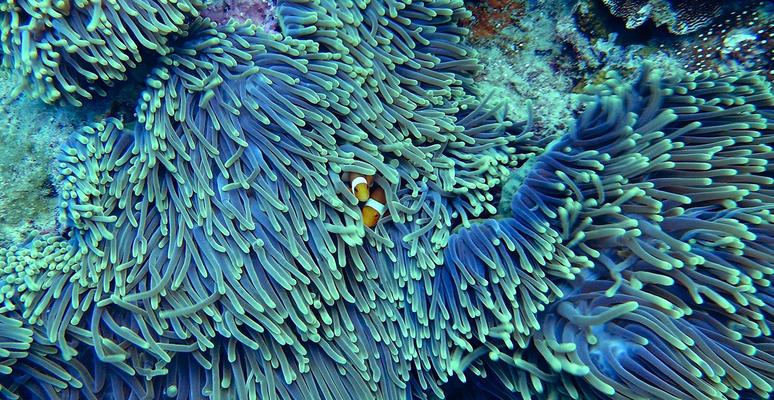
Global Warming’s Evil Twin: Ocean Acidification
But what exactly is ocean acidification? And what does it mean for marine ecosystems and for humans? The answers can be complicated. But before we get into the details, here are some quick facts that show why ocean acidification is a really big deal for our planet – and why we need to keep dirty fossils in the ground:
- Ninety-seven percent of the Earth’s water is in the ocean. And the ocean covers more than 70 percent of the planet's surface.
- Since the beginning of the Industrial Revolution, oceans have absorbed an estimated 525 billion tons of carbon dioxide from the atmosphere.
- The Great Barrier Reef is bleaching rapidly due to climate change and ocean acidification, with only 7 percent of the reef unaffected by the most recent mass bleaching event.
#ScienceSunday: Oceans currently absorb about 25% of the CO2 humans produce every year https://t.co/0P3DGGiyyc pic.twitter.com/CumyNXdVvq
— Climate Reality (@ClimateReality) April 4, 2016
So, exactly what is ocean acidification?
Our oceans are an incredible carbon sink — they absorb about 25 percent of the carbon dioxide humans produce every year. But this is changing sea surface chemistry dramatically: when carbon dioxide is absorbed by the ocean, it dissolves to form carbonic acid. The result, not surprisingly, is that the ocean becomes more acidic, upsetting the delicate pH balance that millions and millions of organisms rely on.
Since the Industrial Revolution, our seas have become about 30 percent more acidic, a rate not observed in 300 million years. This has a wide range of consequences for marine ecosystems, as well as for the billions of people who depend on the ocean for food and survival.
#ScienceSunday: CO2 mixes with seawater to form carbonic acid, making oceans more acidic https://t.co/0P3DGGiyyc pic.twitter.com/wL7r8pu3K6
— Climate Reality (@ClimateReality) April 3, 2016
Ocean acidification is often called global warming’s evil twin.
Oceans becoming more acidic after the Industrial Revolution is no accident. As humans burn more and more fossil fuels, the concentration of carbon dioxide in our atmosphere continues to rise, driving climate change and making both air and sea temperatures hotter and hotter.
But climate change isn’t the only consequence of carbon pollution — so is ocean acidification. With more and more carbon dioxide in the atmosphere, oceans absorb more and more of it, becoming – you guessed it – more and more acidic. This is happening at an unprecedented rate and will continue unabated if we don’t stop burning dirty fossil fuels.
#ScienceSunday: Ocean acidification also contributes to coral bleaching and die-off https://t.co/RxZbTiNiT5 pic.twitter.com/QJwleS841c
— Climate Reality (@ClimateReality) April 4, 2016
What are the consequences of ocean acidification?
Ocean acidification doesn’t just threaten marine ecosystems. It also puts pressure on human food systems and affects the livelihood of people who depend on the ocean for their income in every way from fishing to tourism.
One reason why? Because as oceans become more acidic, some sea creatures have a more difficult time forming shells, including coral polyps. These are the “tiny builders” of coral reefs — when a polyp attaches to a rock on the seafloor, it divides into many clones and eventually creates a reef. Ocean acidification can slow the growth of coral skeletons, and make reefs more brittle and less resistant to stressors like warming water temperatures.
Keeping coral reefs healthy and growing is vital. Reefs protect our coastlines from erosion and flooding, support local economies through tourism and fisheries, and host vastly productive ecosystems. The US National Oceanic and Atmospheric Administration, for example, estimates that about half a billion people live within 100 kilometers of a coral reef and benefit from the protection and natural resources it offers. Globally, coral reefs may provide goods and services worth $375 billion each year, which means threats to reefs have profound ripple effects.
#ScienceSunday: Coral can recover from mild bleaching, but severe bleaching is often lethal https://t.co/ShW6EjFBOY pic.twitter.com/GAMLf3mNYI
— Climate Reality (@ClimateReality) April 4, 2016
What’s happening when coral becomes bleached?
You’ve probably heard a lot lately about mass coral bleaching events in places like the Great Barrier Reef. As NPR explains, “Coral bleaching occurs when the living organisms that make up coral reefs expel the colorful, photosynthetic algae that normally live inside their bodies, and provide them with food. Those algae give coral reefs their color and disappear when the reefs are exposed to stressful climatic conditions, such as temperatures even a few degrees higher than normal.”
>>> Related: Climate Change is “Devastating” The Great Barrier Reef <<<
Coral reefs are considered to be the most biodiverse ecosystem on the planet. When coral is hit hard by both ocean acidification and climate change, so too are the many species that humans rely on for food. According to the United Nations Environmental Programme, “fish, including shellfish, contribute 15 percent of animal protein for 3 billion people worldwide. A further 1 billion people rely on fisheries for their primary source of protein.”
It’s Easy to Sea: We Need to Take Climate Action for Our Oceans
Just like climate change, ocean acidification is already dramatically impacting people (and species) around the world. To save our oceans and stop climate change, we must transition away from burning dirty fossil fuels.
Sign up to join Climate Reality’s email activist list. We’ll send you the latest on climate science and what you can do to help stop climate change and turn the tide on ocean acidification.

